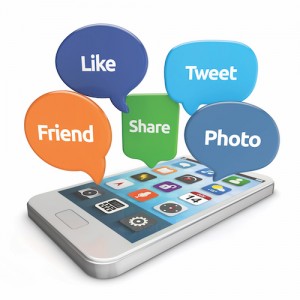Smartphones and social media are so ingrained into our everyday lives, it’s hard to believe that just 15 years ago these industry giants weren’t really around yet. But for today’s high school and college students, social media has been integrated into nearly every aspect of their lives and has had a heavy impact on their development.
Parents and professionals all have their own opinions on whether all this constant connection and technology use is beneficial or detrimental. Some say smartphones are killing face-to-face interaction, while others say they allow for even more communication than before, just through different avenues.
Whether smart phones and social media are good or bad, the fact of the matter is that they are here to stay for the foreseeable future. Let’s take a look at their impact on today’s students, how they can be utilized for good, and how we can minimize their more detrimental aspects.
SMARTPHONE IMPACT
You rarely see a student these days without a smartphone in their hands. Texting, playing games, surfing the web — just about anything can be done on a smartphone. With students constantly staring at their phone and other mobile devices, they could be damaging their eyes, making their vision weaker and potentially causing early onset of macular de- generation. Too much screen time can also cause more frequent headaches and migraines, as well as contribute to sleeplessness and insomnia. Since there is often a propensity to sit and shuffle through apps and feeds for hours at a time, the prolonged sitting time can harm the body by causing weight gain and muscle atrophy, as well as increase the chances of developing heart disease, diabetes, and cancer.
Of course, for every negative aspect of smartphones, there is an app to help combat it. Therein lies the benefit of smartphones and other mobile devices — they make our lives easier with convenient and useful apps accessible anywhere. There are apps to track exercise, food intake, sleep schedules, and even to lock apps for specific amounts of time to limit use. The convenience of apps is especially beneficial to students; education and technology are completely intertwined these days, and with smartphones, students have access to school apps for submitting assignments and tracking classes, as well as apps to help with studying.
In fact, technology use has significantly changed the face of the American classroom in just the last 10 years. According to a survey of 1,000 teachers performed by MidAmerica Nazarene University, 73 percent of the teachers agreed that technology has dramatically changed classrooms in recent years, and 82 percent say that technology has enhanced teaching and learning overall. Despite the positive aspects of the integration of technology in education, 70 percent of teachers say that smartphone use by students still causes tension and distractions in the classroom.
SOCIAL MEDIA IMPACT
Since the first days of MySpace, social media has become bigger than anyone could have imagined. While MySpace seems to be a distant memory, plat- forms like Facebook, Twitter, Instagram, and Snapchat rule the social media realm today. You would be hard- pressed to find a student who doesn’t have at least one of these apps on their phone, if not all of them.
The ever-present nature of social media can have a profound effect on a student’s well-being. It can be a wonderful outlet for connection and creativity. As students graduate from high school and go on to college in different areas of the country — maybe even the world — social media offers easy and interactive ways to keep in touch with old friends and connect with new ones. It’s also a great way for creative students to express themselves and showcase their work.
Of course, social media can also be extremely detrimental. Even with the benefits, there are some serious drawbacks. A problem that runs rampant among students — especially of high school age — is cyberbullying. It’s primarily carried out on social media platforms, where a wide audience and the permanent nature of the internet have taken bullying and harassment to a whole new level that no longer ends with dismissal bell. In addition to cyberbullying, the constant pressure to “keep up appearances” and a whole
world of people to compare to, have caused self-image issues and depression among young people, especially girls, in greater numbers than ever before. Social media is also an easy distraction for students, making it a huge productivity killer when there is homework to be done; this can cause chronic stress and insomnia for students who can’t keep focused.
HOW TO BALANCE THE NEGATIVE AND POSITIVE
Since smartphones and social media are here to stay, and they do offer many benefits, it’s important that students know how to balance their usage. Taking advantage of the best parts of these tools while staving off the detrimental aspects will ensure that their physical and mental well-beings are taken care of.
When it comes to screen time, limiting use is the best way to combat the damaging effects it can have on eyes and the risk of headaches. When long screen sessions can’t be avoided due to studying and homework, students should keep eye health in mind and do things like eye exercises and take scheduled screen breaks. Screen breaks are great times to get in some movement as well and keep those long sessions from getting too sedentary. Students can use those times to do some quick exercises like jumping jacks, get in some stretches, or take a walk around the block. There are apps that can give movement reminders and track steps, so even when taking a screen break, smartphones are still offering benefits.
Limiting social media use is important for both productivity and mental well-being. While electronics and phones are bound to be a part of an average student’s everyday life, social media doesn’t have to be. While one doesn’t have to give up social media completely, taking conscious breaks from it can do wonders for keeping mental health and overall wellbeing in check.
Students can limit everyday use by deleting the apps off their phones and reserving social media checks to just when on a computer. For those who don’t want to delete apps — especially for more smartphone-specific apps like Snapchat and Instagram — stash the apps away in a folder on the last page of apps, making them harder to access and thus removing the ability to constantly check them. Every once in a while, taking a week-long break, or even longer, can be a wonderful social media detox when things feel especially heavy and hopeless. Students with iPhones will soon be able to benefit from new features that will control app and screen time, which will help those who struggle to disengage on their own.
Smartphones and social media have been a big feature in the lives of today’s students, and they aren’t going anywhere anytime soon. As with any technological advancements adopted by younger generations, there are both benefits and detriments. With careful consideration and mindful use, the benefits of smartphones and social media can outweigh the negative aspects. The key to balance is to limit use where possible, and to stay present in the moment when engaging.
Mila Sanchez is a writer with a BA in English Linguistics. Her ambitions include traveling the world, studying languages, and taking pictures of her dog, Baymax. Connect with her on Twitter and Instagram!



